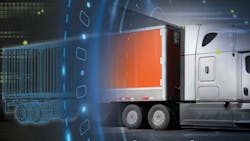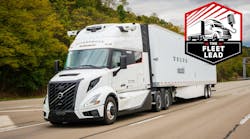Smart trailers: Why autonomous trucking depends on connected trailer technology
Key takeaways
- Smart trailers provide critical data to prevent downtime, improve safety, and optimize fleet operations.
- Autonomous trucking relies on trailer intelligence for predictive maintenance and real-time health monitoring.
- AI and predictive analytics help fleets convert trailer data into actionable insights, reducing costs and inefficiencies.
CANTON, Ohio—The roadmap to autonomous trucking is typically focused on the power unit—the self-driving tractor—but a recent panel of telematics and fleet management experts underscored a crucial truth: The future of driverless long-haul operations rests squarely on the intelligence of the trailer pulled behind that tractor. Without the robust data and predictive capabilities provided by smart-trailer technology, autonomous trucking operations face unacceptable risks and inefficiencies.
Gathered here for a session during Hendrickson’s Beyond Suspensions media event, the smart trailer technology panel detailed how connected equipment is transforming fleet operations and maintenance—and preparing the industry for a safer, autonomous future.
Matt Wilson, who leads Hendrickson's Vehicle Technology Group, explained that his division's creation was rooted in the need to provide fleets and users with sophisticated sensor technology that delivers "data and actionable insights.” These will form the basis for the connected, smart trailers needed for autonomous trucking.
“There's a real focus for us here at Hendrickson to try to make sure that we're providing as much information as possible to fleets and users moving forward,” Wilson said. “So part of that for us is to get a little bit more sophisticated with our products.”
Indeed, smart trailer technology is a collection of sensors, keeping an eye on everything, from trailer hardware to the freight in the box, explained Mark Wallin, general manager and senior vice president of product for Phillips Connect.
“The part that makes it smart is when you bring that all together and create insights for the right stakeholders,” Wallin said. “That is the collection of technologies around smart trailers that we’re really focused on, what the industry is focused on, in terms of bringing better insights, better sensors to drive better decisions.”
But which data points are critical? The foundational, "table stakes" data revolves around lights, brakes, and tires, emphasized Lawrence Bader, retired UPS global fleet systems director, who is currently with Advanced Transportation Technology. He, too, stressed that data must be actionable, meaning it can be put into the hands of the people who can use it immediately.
“All the data elements are important, but when we put them into action, that's where the meat is,” Bader said.
For Jason Theis, fleet maintenance manager for trailers with Anderson Trucking Service (ATS), this focus on data-derived insights resulted in immediate, measurable success. After implementing the Hendrickson’s TiremaaxI Pro advanced automatic tire inflation system, ATS saw a "massive reduction” in CSA violations. Theis noted that underinflated tires were their No. 1 violation, and by combating this persistent issue with technology, they were able to dramatically reduce fines and service violations.
“Getting drivers to stop and check post- and pre-trip is very, very difficult, even with the DVIR [inspection report] process,” Theis said. “So we’re combating technology with technology. When you go through a weigh station, there's AI technology in those stations now. They check the tire tread depth and [inflation] psi just by going through it. So we had to find a way we can be a little more systematic with what we're doing and not do a manual process.”
And the predictive capability—getting ahead of a problem before it escalates—is essential, especially given the true cost of a flat tire once roadside repairs, downtime, and missed appointments are added up. For ATS, that averages $694 above the cost of the tire itself, Theis noted.
How fleets handle connected trailer data overload
While the promise of data is tremendous, fleets face challenges, primarily data overload. Wallin pointed out that managing the complexity and sheer volume of data—and finding what’s important—is difficult.
“There's new technology being added to every part of the trailer, and with all that great new technology and all the new insights, you’ve got to get it to the right place,” Wallin said. “So the challenge for a fleet is, how do you make use of all that information? How do you turn a bunch of data into something that's actionable and really valuable?”
Fleets often struggle to build the necessary IT infrastructure themselves, leading them to seek platforms that simplify data consolidation and delivery.
“That's really what we [Phillips Connect] have been focused on: how to help solve that challenge with technology, with the platform,” Wallin said.
The solution lies in creating "fit for purpose" applications. Dispatchers, mechanics, and drivers all require different information to act efficiently. Instead of forcing users to sift through the same detailed reports, platforms must serve up only the necessary information to the right person at the right time. As a component supplier, Wilson suggested that Hendrickson is looking into edge computing—making certain decisions on the vehicle in real-time—is key to restricting how much non-critical information is sent to the cloud.
“Let's try to make sure that the information that we identify are actual issues—actionable items that we can hand off to telematics systems to then communicate to the back office or the driver,” he said.
Moreover, gaining organizational buy-in requires demonstrating a comprehensive return on investment (ROI). Bader advised fleets to look beyond just the maintenance budget and consider the impact on safety, brand reputation, insurance costs, and operations.
“When you look at all of the other aspects, it's very clear—you just can't look at one piece of it,” Bader said.
How autonomous trucking relies on smart trailer tech
The convergence of smart trailers and autonomous trucking is obvious—or should be.
“The autonomous vehicle age is evolving. All of the AV developers today are looking to deploy with dumb trailers,” Bader said. “I think some of your respectable fleets that do care about their brand image are going to want to ensure that their labeled trailer going down the highway is not at risk from a simple tire blowout, to smoking brakes, to a thermal event. So they are investing in trailer telematics to give us that data. I do believe that autonomous vehicle developers are going to discover how that data can be brought into their systems, and take action on those.”
Smart trailers are crucial because they serve as the technological replacement for the human driver's intuition and observation. They provide the autonomous system with the critical health diagnostics necessary to make safety decisions.
“I absolutely believe we need to understand the true health of that trailer that’s being pulled behind on autonomous vehicles,” Bader continued. “We need to understand when that tire is getting low. Are the wheel bearings holding up? It's a safety issue.”
The application of this smart data extends beyond simple tire pressure alerts. Theis shared an unexpected success story in which telematics data, coupled with the inflation system, enabled ATS to detect improper load distribution on an open-deck trailer, preventing damage to the trailer and educating dispatchers on safe loading practices. Furthermore, ATS integrated Phillips Connect and Hendrickson technology to monitor the unauthorized use of complex steerable trailer systems, ensuring drivers complied with policy restrictions.
These complex insights prove that the systems are customizable and essential for policy compliance and safety in specialized operations.
Using predictive analytics to optimize trailer uptime
Looking toward 2026 and beyond, the panelists agreed that AI is the definitive trend. Wallin of Phillips Connect predicted that AI will raise the bar by enabling greater automation and allowing fleet personnel to ask smarter questions.
“We're going to solve real problems, and that trend in AI is going to open a lot of doors for technology,” Wallin said. “It’s around people's thinking, and what they expect in their day-to-day work. With connected equipment, like we have here at Hendrickson, and the platform that we're working on, we're going to make that easier, and this trend will be very helpful for the industry.”
Bader pointed to the transformative aspects of physics-based AI. This advanced AI will be able to dig into data and predict component failure, moving the industry away from traditional time- and mileage-based maintenance schedules toward condition-based maintenance by “understanding where the problems really are.” This means replacing parts like brake pads or starters only when the prediction models indicate imminent failure, maximizing resource utilization, and minimizing premature replacement.
For fleets, operational insights offer a tremendous opportunity.
“We're in a down market right now, so asset management is important,” ATS’ Theis said. “Our ops group, they're constantly looking at the trailer counts: Where are they? How long have they been sitting there? What's the load status? Time is money, and every load counts right now. So we're really looking to utilize all the resources and data that's out there, using the AI.
“Getting the right truck-to-trailer ratio, it's always been a guessing game. We're finding that we don't need as many trailers in the fleet because we have so many that are underutilized. So we're really watching that ratio, getting it as close as we can to make sure we have enough for the customers, and that they're still turning their wheels as much as they can. I think the AI's going to be a big portion of that analysis.”
Hendrickson’s Wilson summarized the industry’s near-term challenge: achieving clarity.
“Over the next year or two, you're going to see a lot of users figure out what are the most important parts and what are the most important things for them to pay attention to,” Wilson said. “Because, right now, I think there's still a little bit of confusion over what sensors are the ones that I really need to have in my trailer; there's almost information overload in some cases. The industry as a whole is going to get some clarity over the next year or so and really figure out and dial-in the specific sensors, the specific requirements that they need to monitor to make sure that their equipment is healthy and working properly.”
About the Author
Kevin Jones
Editor
Kevin has served as editor-in-chief of Trailer/Body Builders magazine since 2017—just the third editor in the magazine’s 60 years. He is also editorial director for Endeavor Business Media’s Commercial Vehicle group, which includes FleetOwner, Bulk Transporter, Refrigerated Transporter, American Trucker, and Fleet Maintenance magazines and websites.
Working from Beaufort, S.C., Kevin has covered trucking and manufacturing for nearly 20 years. His writing and commentary about the trucking industry and, previously, business and government, has been recognized with numerous state, regional, and national journalism awards.



